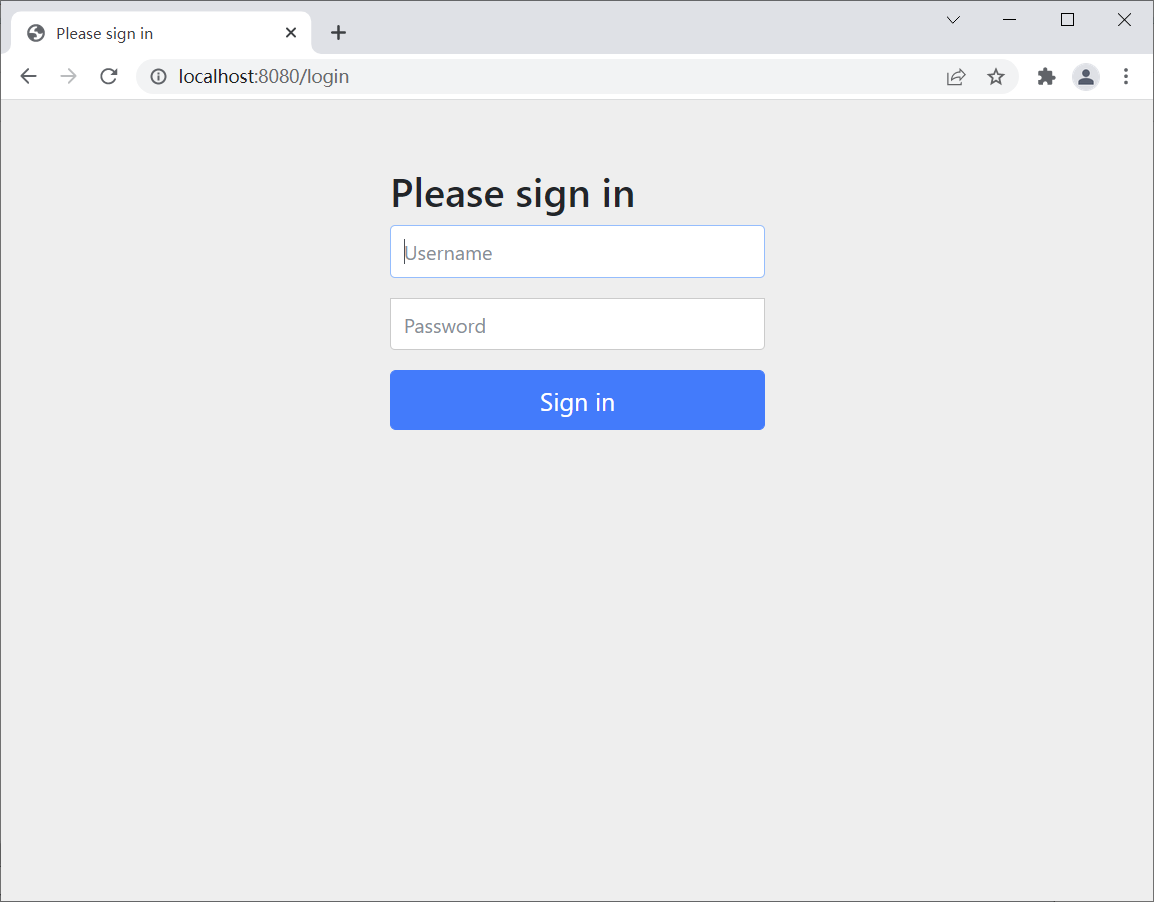详解springboot springsecuroty中的注销和权限控制问题
目录
- 1账户注销
- 1.1在SecurityConfig中加入开启注销功能的代码
- 1.2在index.html添加注销的按钮
- 1.3启动项目测试
- 2权限控制
- 2.1导入springsecurity和thymeleaf的整合依赖
- 2.2springboot版本降级
- 2.3引入约束
- 2.4修改页面代码
- 2.5重启程序测试
上篇文章给大家介绍了springboot对接第三方微信授权及获取用户的头像和昵称等等
1 账户注销
1.1 在SecurityConfig中加入开启注销功能的代码
src/main/java/com/lv/config/SecurityConfig.java
package com.lv.config;
import org.springframework.security.config.annotation.authentication.builders.AuthenticationManagerBuilder;
import org.springframework.security.config.annotation.web.builders.HttpSecurity;
import org.springframework.security.config.annotation.web.configuration.EnableWebSecurity;
import org.springframework.security.config.annotation.web.configuration.WebSecurityConfigurerAdapter;
import org.springframework.security.crypto.bcrypt.BCryptPasswordEncoder;
//AOP : 拦截器!
@EnableWebSecurity
public class SecurityConfig extends WebSecurityConfigurerAdapter {
//授权
@Override
public void configure(HttpSecurity http) throws Exception {
//首页所有人都可以访问,功能页只有对应的有权限的人才能访问
//请求授权的规则~(链式编程)
http.authorizeRequests()
.antMatchers("/").permitAll()
.antMatchers("/level1/**").hasRole("vip1")
.antMatchers("/level2/**").hasRole("vip2")
.antMatchers("/level3/**").hasRole("vip3");
//没有权限默认会跳转到登录页,需要开启登录页面
http.formLogin();
//注销,开启了注销功能,跳到首页
http.logout().logoutSuccessUrl("/");
//防止跨站工具, get,post
http.csrf().disable();//关闭csrf功能,注销失败可能的原因
}
//认证,springboot 2.1.x 可以直接使用
//密码编码:PasswordEncoder
//在Spring Security 5.0+ 新增了很多加密方法~
protected void configure(AuthenticationManagerBuilder auth) throws Exception {
//这些数据正常应该从数据库中读
auth.inMemoryAuthentication().passwordEncoder(new BCryptPasswordEncoder())
.withUser("lv").password(new BCryptPasswordEncoder().encode("123456")).roles("vip2","vip3")
.and()
.withUser("root").password(new BCryptPasswordEncoder().encode("123456")).roles("vip1","vip2","vip3")
.withUser("guest").password(new BCryptPasswordEncoder().encode("123456")).roles("vip1");
}
1.2 在index.html 添加注销的按钮
src/main/resources/templates/index.html
<!--登录注销-->
<div class="right menu">
<div>
<a class="item" th:href="@{/toLogin}">
<i class="address card icon"></i>登录
</a>
</div>
<div>
<a class="item" th:href="@{/logout}">
<i class="sign-out icon"></i>注销
</a>
</div>
</div>
1.3 启动项目测试
访问登录页面,登录 guest 账户,该账户可以访问 level1的页面

登录成功后,点击 level1的链接,成功跳转到 level 页面,然后点击注销按钮

弹回到首页,再次点击点击 level1 页面

跳转到了登录页面

说明账户注销成功
2 权限控制
2.1 导入springsecurity和thymeleaf的整合依赖
pom.xml
<!-- springSecurity和thymeleaf整合包 -->
<dependency>
<groupId>org.thymeleaf.extras</groupId>
<artifactId>thymeleaf-extras-springsecurity4</artifactId>
<version>3.0.2.RELEASE</version>
</dependency>
2.2 springboot版本降级
pom.xml
<parent>
<groupId>org.springframework.boot</groupId>
<artifactId>spring-boot-starter-parent</artifactId>
<version>2.0.9.RELEASE</version>
<relativePath/> <!-- lookup parent from repository -->
</parent>
必须将springboot的版本降到2.0.9以下,否则 sec:authorize="isAuthenticated()" 不会生效.版本降低后,需要手动导入junit依赖,否则测试类会报错
<dependency>
<groupId>org.junit.jupiter</groupId>
<artifactId>junit-jupiter</artifactId>
<version>RELEASE</version>
<scope>test</scope>
</dependency>
2.3 引入约束
在index.html的头文件中添加springsecurity和thymeleaf的整合约束
src/main/resources/templates/index.html
<html xmlns:th="http://www.thymeleaf.org"
xmlns:sec="http://www.thymeleaf.org/thymeleaf-extras-springsecurity4">
2.4 修改页面代码
主要修改两部分,一部分是登录状态下显示用户名,和注销按钮,未登录显示登录按钮 通过 sec:authorize="isAuthenticated()" 实现.另一部分是根据登录用户的权限显示不同的页面菜单,通过 sec:authorize="hasRole('vip1')" 实现.
src/main/resources/templates/index.html
<!DOCTYPE html>
<html xmlns:th="http://www.thymeleaf.org"
xmlns:sec="http://www.thymeleaf.org/thymeleaf-extras-springsecurity4">
<head>
<meta charset="UTF-8">
<meta name="viewport" content="width=device-width, initial-scale=1, maximum-scale=1">
<title>首页</title>
<!--semantic-ui-->
<link href="https://cdn.bootcss.com/semantic-ui/2.4.1/semantic.min.css" rel="stylesheet">
<link th:href="@{/qinjiang/css/qinstyle.css}" rel="stylesheet">
</head>
<body>
<!--主容器-->
<div class="ui container">
<div class="ui segment" id="index-header-nav" th:fragment="nav-menu">
<div class="ui secondary menu">
<a class="item" th:href="@{/index}">首页</a>
<!--登录注销-->
<div class="right menu">
<!--如果未登录:显示登录按钮-->
<div sec:authorize="!isAuthenticated()">
<a class="item" th:href="@{/toLogin}">
<i class="address card icon"></i>登录
</a>
</div>
<!--如果已登录:显示用户名和注销按钮-->
<div sec:authorize="isAuthenticated()">
<a class="item">
用户名:<span sec:authentication="name"></span>
</a>
</div>
<div sec:authorize="isAuthenticated()">
<a class="item" th:href="@{/logout}">
<i class="sign-out icon"></i>注销
</a>
</div>
</div>
</div>
</div>
<div class="ui segment" style="text-align: center">
<h3>Spring Security Study by 秦疆</h3>
</div>
<div>
<br>
<div class="ui three column stackable grid">
<!--菜单根据用户的角色动态实现-->
<div class="column" sec:authorize="hasRole('vip1')">
<div class="ui raised segment">
<div class="ui">
<div class="content">
<h5 class="content">Level 1</h5>
<hr>
<div><a th:href="@{/level1/1}"><i class="bullhorn icon"></i> Level-1-1</a></div>
<div><a th:href="@{/level1/2}"><i class="bullhorn icon"></i> Level-1-2</a></div>
<div><a th:href="@{/level1/3}"><i class="bullhorn icon"></i> Level-1-3</a></div>
</div>
</div>
</div>
</div>
<div class="column" sec:authorize="hasRole('vip2')">
<div class="ui raised segment">
<div class="ui">
<div class="content">
<h5 class="content">Level 2</h5>
<hr>
<div><a th:href="@{/level2/1}"><i class="bullhorn icon"></i> Level-2-1</a></div>
<div><a th:href="@{/level2/2}"><i class="bullhorn icon"></i> Level-2-2</a></div>
<div><a th:href="@{/level2/3}"><i class="bullhorn icon"></i> Level-2-3</a></div>
</div>
</div>
</div>
</div>
<div class="column" sec:authorize="hasRole('vip3')">
<div class="ui raised segment">
<div class="ui">
<div class="content">
<h5 class="content">Level 3</h5>
<hr>
<div><a th:href="@{/level3/1}"><i class="bullhorn icon"></i> Level-3-1</a></div>
<div><a th:href="@{/level3/2}"><i class="bullhorn icon"></i> Level-3-2</a></div>
<div><a th:href="@{/level3/3}"><i class="bullhorn icon"></i> Level-3-3</a></div>
</div>
</div>
</div>
</div>
</div>
</div>
</div>
<script th:src="@{/qinjiang/js/jquery-3.1.1.min.js}"></script>
<script th:src="@{/qinjiang/js/semantic.min.js}"></script>
</body>
</html>
2.5 重启程序测试
未登录页面

登录 lv 用户的页面

登录 geust 用户的页面

登录 root 用户的页面

页面显示都不同,权限控制成功实现
到此这篇关于springboot-springsecuroty 注销和权限控制的文章就介绍到这了,更多相关springboot注销和权限控制内容请搜索我们以前的文章或继续浏览下面的相关文章希望大家以后多多支持我们!

